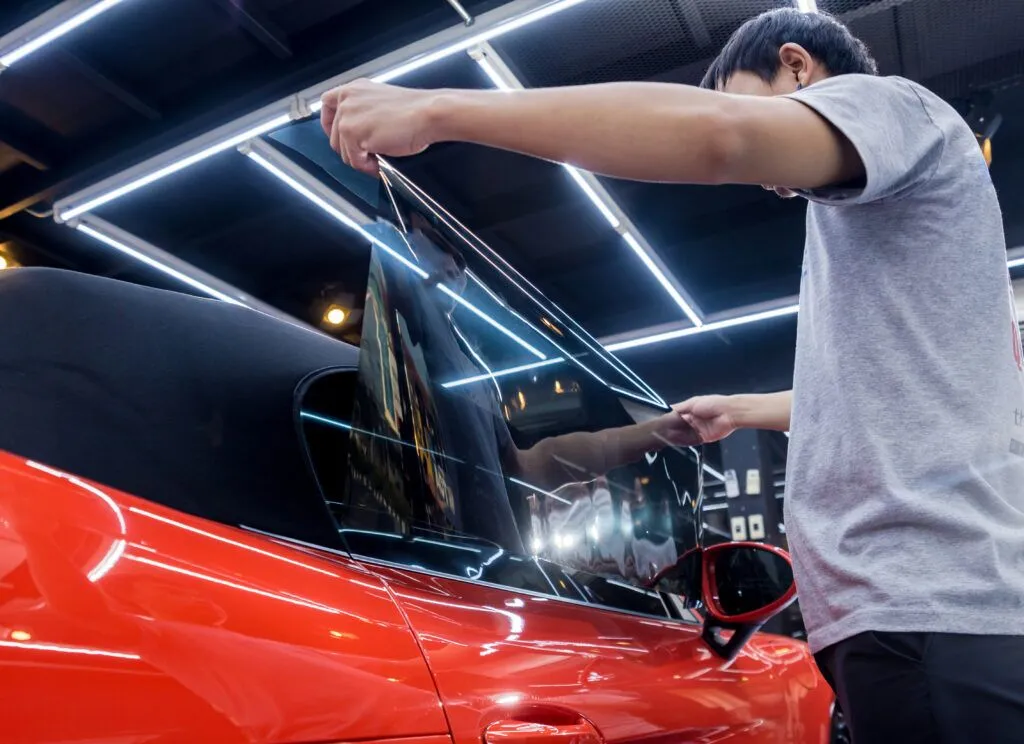car window tinting offers more than just aesthetic appeal—it’s a practical enhancement that provides privacy, UV protection, and improved comfort. Whether you’re exploring options for the first time or upgrading an existing tint, making the right choice involves several considerations. From understanding legal regulations to selecting the right materials and installation techniques, this guide will walk you through the steps to ensure you pick the ideal car window tint for your needs.
Table of Contents
Toggle1. The Benefits of Car Window Tinting
Before diving into the specifics, it’s essential to recognize the advantages of car window tinting:
- UV Protection: High-quality window films block up to 99% of harmful UV rays, safeguarding both your skin and your car’s interior from sun damage.
- Privacy and Security: Tints obscure the view into your car, offering increased privacy and deterring potential theft.
- Temperature Control: Tinted windows reduce heat buildup inside your car, making it more comfortable and less reliant on air conditioning.
- Glare Reduction: By minimizing glare from sunlight and headlights, window tinting enhances safety and reduces eye strain.
Knowing these benefits can help you determine which aspects to prioritize when choosing a tint.
2. Familiarize Yourself with Local Tinting Laws
Window tint regulations vary by location, dictating how dark or reflective your tint can be for different windows.
For instance, front side windows often require a lighter tint to maintain clear visibility, while rear windows may allow darker shades. Researching the regulations in your area or consulting a professional installer will ensure your tinting complies with local laws, saving you from fines or the hassle of removal.
3. Choose the Right Tint Darkness Level
Tint darkness is measured by Visible Light Transmission (VLT), which indicates how much light passes through the film. Common options include:
- 50% VLT: Allows significant light in, offering moderate glare reduction with minimal privacy.
- 35% VLT: A popular choice that balances style, visibility, and privacy.
- 20% VLT: Ideal for enhanced privacy while maintaining functional visibility.
- 5% VLT: Known as “limo tint,” this is the darkest option, often used for rear windows.
Select a level that aligns with your needs for privacy, glare reduction, and compliance with local laws.
4. Explore Different Window Tint Film Types
Car window tints come in various materials, each with unique characteristics:
- Dyed Films: Affordable and effective at reducing glare, but prone to fading over time.
- Metalized Films: Reflect sunlight and enhance window strength but can interfere with GPS and radio signals.
- Carbon Films: Offer excellent UV and heat protection without signal interference. Their matte finish adds a sleek appearance.
- Ceramic Films: Premium quality with superior heat rejection, UV protection, and durability. They don’t fade or impact electronics.
- Hybrid Films: Combine dyed and metalized features for a balance of cost, performance, and durability.
Consider your budget and desired features to pick the best material for your vehicle.
5. Prioritize Quality Over Price
Opting for a cheap tint may save you money upfront, but low-quality films are more likely to peel, bubble, or discolor. Investing in a high-grade tint ensures long-term performance and value.
Brands like 3M, Llumar, and SunTek are known for their reliable quality and warranties. Additionally, professional installation is key to avoiding common issues and ensuring a flawless finish.
6. Match Your Tint to Your Aesthetic Goals
Car window tinting is as much about style as it is about function. Different shades and finishes can complement your car’s design.
For example, a matte ceramic tint creates a modern, understated look, while reflective metalized tints offer a bold, eye-catching appearance. You can also opt for consistent tint levels across all windows or vary them based on functionality and local regulations.
7. Choose a Skilled Installer
A professional installer ensures your car window tinting is done correctly, avoiding issues like bubbles, peeling, or uneven coverage.
When selecting an installer:
- Review Their Work: Ask for photos of past projects or read customer reviews to gauge quality.
- Inquire About Warranties: Reputable installers often provide warranties on both the film and the installation.
- Verify Certifications: Certified installers have undergone training to work with specific brands and materials.
8. Maintain Your Window Tint for Longevity
To keep your tint looking and performing its best, follow these maintenance tips:
- Allow Proper Curing Time: Avoid rolling down windows for 3–7 days after installation.
- Use Gentle Cleaners: Stick to ammonia-free glass cleaners and soft cloths to prevent damage.
- Inspect Regularly: Check for any bubbling or peeling and address issues promptly with your installer.
Conclusion
Choosing the right car window tinting involves balancing functionality, style, and compliance with local laws. By understanding the benefits, selecting the appropriate material and VLT level, and working with a reputable installer, you can enhance your car’s comfort, safety, and aesthetic appeal. Don’t rush the process—invest in quality materials and professional installation for results that will last for years.
Enjoy the enhanced driving experience that comes with the perfect window tint!









